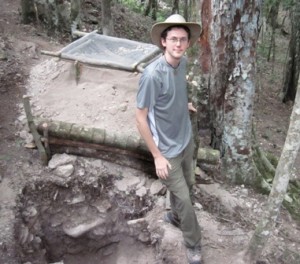By Michele Tallarita ’12

Jared Katz '12 in Guatemala
Jared Katz ’12 was one of the few undergrads selected to present research at the Society for American Archeology (SAA) annual meeting in Memphis, Tenn., last month. Katz, who graduated May 19, presented a paper entitled “Music of the Grave: The Significance of Music in Ancient Maya Funerary Ceremonies.”
The SAA is an international organization dedicated to the research, interpretation, and protection of the archaeological heritage of the Americas. The annual meeting attracts more than 3,000 archeologists from around the world, and incorporates a vast range of topics and many time periods.
“Archeology allows scholars to give a voice to people and cultures that may have otherwise been forgotten throughout time,” says Katz.
As a first-year student, his interest in the field compelled him to design his own archeology major to accompany his history degree, a decision with which he’s been “very happy.” His senior year, when it came time to choose a topic for his honors thesis, he knew he wanted to explore the ancient Maya.
“The spring of my sophomore year I lived in the Guatemalan rainforest and helped to excavate two ancient Maya sites,” he says. “I loved the experience and I wanted to continue to focus on the Maya’s culture.”
A conversation with one of his professors convinced him to zero in on the music of the ancient Maya world, which fascinated him as a musician himself and as a topic with little scholarship. In his thesis, he gives an exhaustive account of the instruments found at various archeological sites, the role of music in rituals, and the interaction of music with class, occupation, gender, age, and religion in Maya society. His thesis adviser was Ingrid Furniss, assistant professor of art.
“Musicians were present at ceremonies ranging from human sacrifice to celebrations of dance, indicating that the Maya respected the art form of music,” he says.
At the conference, Katz’s research was well received, and he enjoyed mingling with archeology’s elite.
“I met a number of prolific scholars whom I have read in the past and a number I have cited in my thesis,” he says, adding that several professors told him they intended to incorporate his research in their lectures. The connections he forged also opened up possibilities for co-authoring an article this summer and analyzing Maya instruments stored in Boston’s Museum of Fine Arts.
On campus, he also performed EXCEL research with Furniss on the history of lutes in Asia, and worked as a Grand Challenges Scholar with Katherine Metcalf ’12 and Carolynn Van Dyke, March Professor of English, on ways to improve electronic translation programs by studying ancient languages.
Next year, Katz will head to the University of California Riverside with the Chancellor’s Distinguished Fellowship. He will pursue a Ph.D. in anthropology, and intends to become a professor of Mesoamerican archeology.
In addition to his extensive research, Katz leaves Lafayette with several legacies: he was co-founder of the Quidditch Team, a mentor writing associate, a member of the Division I fencing team, and a member of the Lafayette Leadership Education Committee.
